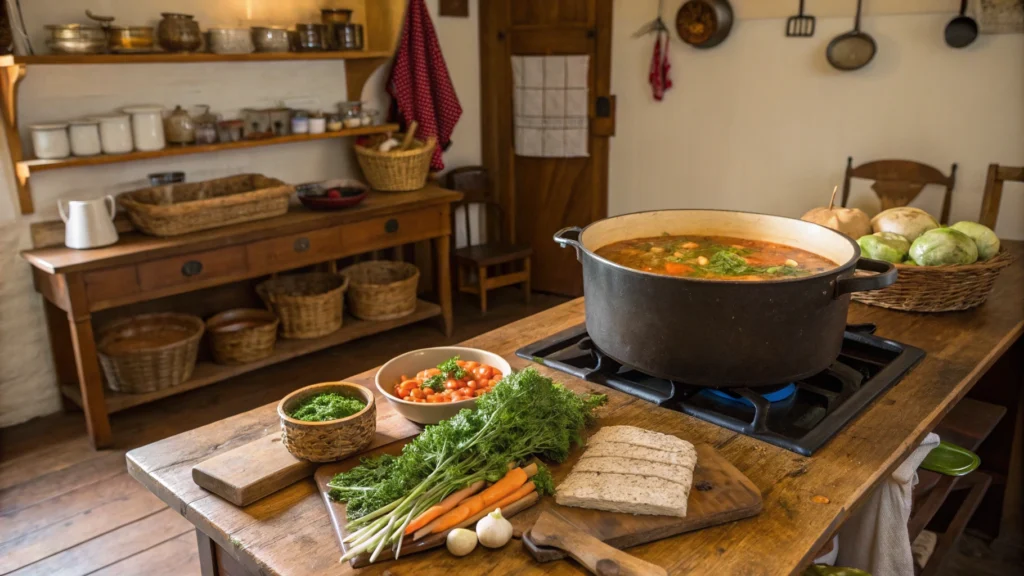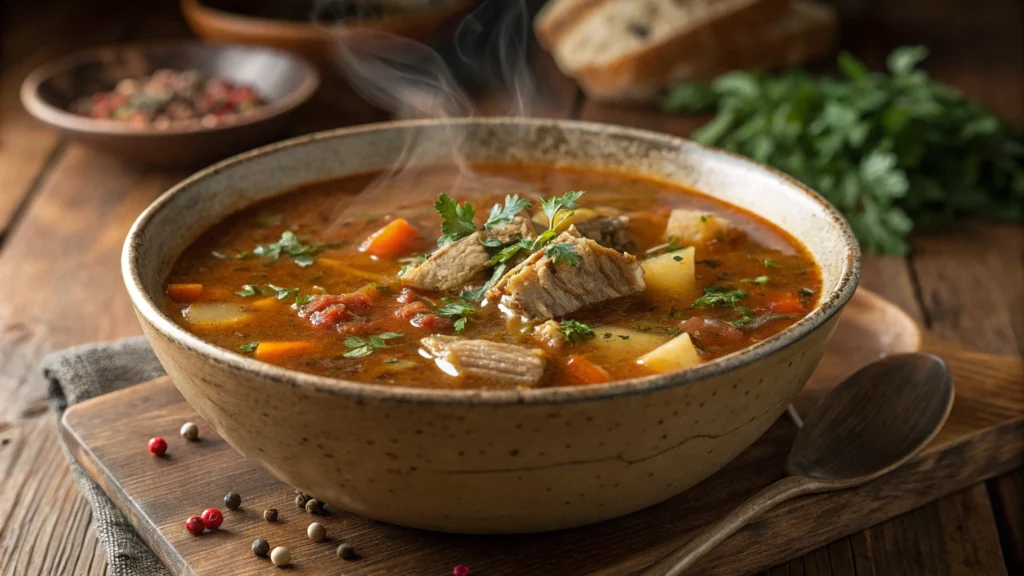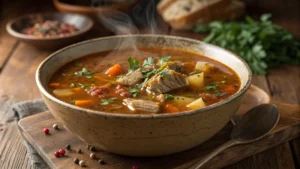There’s something magical about a bowl of homemade soup, especially when it carries the warmth and authenticity of a village kitchen. Across the world, small rural communities have perfected the art of soup-making, passing down secret techniques, unique ingredients, and slow-cooking traditions from generation to generation. But what makes these soups so special?
In this article, we’ll explore the Village Soup Secrets—those age-old methods, locally sourced ingredients, and hidden tricks that transform a simple pot of soup into a heartwarming masterpiece. Whether it’s a rustic Italian minestrone, a nourishing Asian broth, or a classic French potage, village soups hold the key to flavor, nutrition, and tradition.
Table of Contents
The Essential Ingredients of a Village Soup
The foundation of any great soup lies in its ingredients. Unlike commercial broths and canned soups, village-style soups rely on fresh, locally sourced, and seasonal ingredients. These simple yet powerful components enhance flavor, texture, and nutritional value.
1. Fresh and Seasonal Vegetables
One of the defining Village Soup Secrets is the use of farm-fresh, seasonal vegetables. Villagers often harvest what’s available in their gardens or local markets, ensuring maximum flavor and nutrients. Some of the most common vegetables used include:
- Root vegetables (carrots, potatoes, parsnips) for a hearty base
- Leafy greens (kale, spinach, cabbage) for a touch of bitterness and extra vitamins
- Aromatic vegetables (onions, garlic, leeks) to build deep flavors
Using seasonal produce not only enhances taste but also supports sustainability, a core principle in traditional cooking.
2. Homemade Broths and Stocks
A good soup starts with a well-crafted broth or stock, which serves as the backbone of the dish. Unlike store-bought options filled with preservatives, homemade broths are slow-simmered for hours, extracting rich nutrients and umami flavors. Villagers typically prepare their stocks using:
- Animal bones (chicken, beef, or fish) for a rich, gelatinous broth
- Vegetable scraps (carrot tops, celery leaves, herb stems) for an earthy, plant-based stock
- Fermented or aged ingredients like miso or dried mushrooms for depth
This time-honored technique brings out natural flavors without relying on artificial enhancers.
3. Herbs and Wild Foraged Additions
Another Village Soup Secret is the use of wild herbs and foraged ingredients that grow naturally in the surrounding environment. From Mediterranean rosemary to Asian lemongrass, herbs elevate the soup’s taste and aroma. Some traditional choices include:
- Bay leaves, thyme, and sage for depth and warmth
- Wild mushrooms and truffles for an earthy, umami kick
- Edible flowers and seaweed for subtle complexity
Foraging for ingredients not only enhances the soup’s uniqueness but also connects people to nature, a value deeply rooted in village traditions.
4. Handmade Noodles, Dumplings, and Grains
Unlike store-bought pasta or rice, many village soups incorporate handmade elements like noodles, dumplings, or grains to add texture and substance. Examples include:
- Rustic wheat noodles in European broths
- Rice and barley in Eastern European and Asian soups
- Hand-rolled dumplings in traditional stews
Slow Cooking and Time-Tested Methods

One of the most closely guarded Village Soup Secrets is the use of slow cooking techniques. Unlike fast-paced modern cooking, village-style soups rely on patience, allowing ingredients to simmer and develop complex, deep flavors over time.
1. The Magic of Slow Simmering
Slow cooking is the heart of many traditional soups, transforming simple ingredients into rich, nourishing meals. Villagers often use clay pots, cast iron cauldrons, or wooden stoves to ensure gentle heat distribution. Here’s why slow simmering works wonders:
- Enhances flavor – Slowly releasing the natural sugars and umami compounds in vegetables and bones
- Improves texture – Softens tough cuts of meat, grains, and legumes for a melt-in-your-mouth experience
- Extracts nutrients – Maximizes the health benefits of bones, herbs, and spices
A perfect example is the bone broth used in many cultures. Cooking bones for 12-24 hours allows minerals and collagen to seep into the broth, making it incredibly nutritious.
2. Clay Pots and Traditional Cookware
The choice of cookware plays a significant role in Village Soup Secrets. While modern kitchens rely on stainless steel and non-stick pots, traditional villages often use:
- Clay pots – Retain moisture and add an earthy aroma to soups
- Cast iron cauldrons – Distribute heat evenly and hold temperature for long cooking times
- Wooden ladles – Preserve delicate flavors and prevent metallic aftertastes
For instance, in parts of India, lentil-based soups like dal are slow-cooked in clay pots, enhancing the depth of flavor with every simmer.
3. Layering Ingredients for Maximum Flavor
A secret technique many village cooks use is layering flavors during cooking. Instead of dumping all ingredients into a pot at once, they follow a structured process:
- Sauté aromatics first – Garlic, onions, and leeks are gently cooked to build a strong foundation.
- Add spices and herbs early – This allows them to bloom and release essential oils.
- Introduce proteins and starchy vegetables next – Meat, potatoes, or legumes slowly absorb the surrounding flavors.
- Pour in broth last – Ensuring all flavors meld together harmoniously over time.
This method prevents any one ingredient from overpowering the dish, creating a perfectly balanced soup.
4. Fermentation and Aging for Deeper Taste
Another hidden gem among Village Soup Secrets is the use of fermented ingredients. Many traditional soups benefit from slightly aged or fermented elements, such as:
- Miso and soy sauce – Common in Japanese broths, adding umami depth
- Fermented vegetables – Like kimchi or sauerkraut, which lend a tangy complexity
- Aged meats and dried fish – Found in Mediterranean and Asian soups for a rich umami base
These ingredients enhance both flavor and gut health, making village soups not just delicious but also incredibly beneficial for digestion.
Read More: Village Soup Connecting Communities
Many traditional soup recipes are passed down through generations, strengthening cultural ties and preserving ancient cooking methods. This deep connection to heritage is what makes village soups so special.
Secret Spice Blends and Flavor Enhancers
Beyond slow cooking, the real secret to unforgettable village soups lies in the careful use of spices, herbs, and natural enhancers. These elements don’t just add heat or aroma—they build layers of complexity that make every bite deeply satisfying.
1. The Role of Spices in Traditional Soups
Spices are more than just seasonings—they serve medicinal, preservative, and flavor-boosting roles. Some of the most common spices found in village soups include:
- Turmeric – Anti-inflammatory and adds a golden hue to broths
- Cumin – Enhances warmth and earthy notes, common in Middle Eastern and Indian soups
- Cinnamon and nutmeg – Bring warmth and depth to Moroccan and European stews
In Thai village soups, galangal and lemongrass are often added to provide a citrusy balance, making each sip refreshing yet bold.
2. Fresh vs. Dried Herbs: When to Use Each
Many home cooks wonder whether fresh or dried herbs are better. The truth is, both have their place in Village Soup Secrets:
- Fresh herbs (cilantro, basil, parsley) – Best added at the end for a bright, fresh finish.
- Dried herbs (oregano, thyme, rosemary) – Work better when simmered for hours, slowly releasing their oils.
A trick many village cooks use is crushing dried herbs in their hands before adding them to the pot—this helps activate their essential oils, intensifying their flavor.
3. Natural Umami Boosters for Depth
Umami, known as the “fifth taste,” is essential for creating soups with depth and complexity. Instead of artificial flavor enhancers, villages use natural umami boosters, such as:
- Dried mushrooms – Shiitake or porcini add a deep, meaty richness
- Anchovies or fish sauce – Found in Mediterranean and Asian broths for a salty umami punch
- Roasted tomatoes and caramelized onions – Naturally sweet and packed with umami
Adding these ingredients can make even the simplest broth taste like it’s been simmering for days.
4. Balancing Sweet, Sour, Salty, and Bitter Elements
The best village soups don’t just rely on salt for seasoning—they balance all taste elements harmoniously. Here’s how village cooks achieve this balance:
- Sweetness – From carrots, parsnips, or caramelized onions
- Sourness – A splash of vinegar, lemon juice, or fermented foods
- Saltiness – Naturally derived from sea salt, fish sauce, or aged cheese
- Bitterness – Using bitter greens like kale or dandelion leaves for contrast
I didn’t find any additional relevant internal linking opportunities beyond the previously mentioned Village Soup: Connecting Communities. If you’d like, I can suggest checking out another recipe article on the site. Now, let’s continue with Part 4 and Part 5 of the article.
Village Soup Secrets from Around the World

Every culture has its own version of a comforting, slow-simmered soup, and many of them hold hidden tricks and techniques passed down through generations. From Europe to Asia, these Village Soup Secrets tell the story of tradition, resourcefulness, and flavor.
1. French Pot-au-Feu: The Art of Layering Flavors
Pot-au-feu, a classic French beef stew, follows the same slow-cooking principles found in many village soups. The secret? Adding ingredients in stages:
- First, simmer the bones – This extracts collagen and richness.
- Next, add root vegetables – Carrots, leeks, and turnips soften in the broth.
- Finally, toss in fresh herbs – Thyme, bay leaves, and parsley bring brightness.
A key element of this dish is the long, gentle cooking time, which allows the broth to develop a deep, meaty flavor without overcooking the vegetables.
2. Japanese Miso Soup: The Power of Fermented Ingredients
Japanese miso soup is one of the simplest yet most nutritious village-style broths. The secret? Fermented miso paste, which is rich in probiotics and umami. Unlike Western soups that simmer for hours, miso soup is prepared using a different technique:
- The broth (dashi) is made with kombu (seaweed) and bonito flakes.
- Miso paste is added at the very end to preserve its probiotics.
- Fresh ingredients like tofu, mushrooms, and scallions are stirred in right before serving.
This balance of lightness and depth makes miso soup a staple in Japanese homes.
3. Italian Minestrone: Maximizing Seasonal Vegetables
Minestrone is an iconic Italian soup packed with seasonal vegetables, beans, and pasta. The best minestrone is not rushed—Italian grandmothers know that the trick is building layers of flavor:
- Sautéing onions, garlic, and celery in olive oil before adding liquid.
- Using a Parmesan rind while simmering to add a subtle umami richness.
- Stirring in pasta at the last minute so it stays al dente.
Each region of Italy has its own version, but one thing remains the same—fresh, high-quality ingredients make all the difference.
4. West African Peanut Soup: Combining Sweet and Savory
West African peanut soup is an incredible example of using simple, bold ingredients to create something unforgettable. The secret ingredient? Ground peanuts or peanut butter, which gives the soup its creamy texture and deep nutty taste. Traditional recipes also use:
- Tomatoes and onions for a natural sweetness.
- Spices like ginger and chili peppers to create warmth.
- Leafy greens like collards or spinach for a nutritious boost.
This soup perfectly illustrates the Village Soup Secrets of combining available ingredients to craft something rich, filling, and deeply satisfying.
5. Filipino Sinigang: The Secret of Sour Broth
In the Philippines, sinigang is a beloved soup known for its distinct sour and savory balance. The secret lies in tamarind, a fruit that gives the broth a unique tangy flavor. Other variations use green mangoes, calamansi, or guava. Key elements of sinigang include:
- Pork or shrimp as the protein base.
- A mix of fresh vegetables like okra, eggplant, and kangkong (water spinach).
- The careful timing of adding souring agents—too early, and they lose their punch; too late, and they don’t blend properly.
Sinigang is a great example of how different cultures develop soups based on their local ingredients and tastes.
Tips for Making the Perfect Village Soup at Home
Now that we’ve explored the history, techniques, and global inspirations behind Village Soup Secrets, it’s time to bring those flavors into your own kitchen. Here are some essential tips for making the perfect village soup at home.
1. Use the Right Cooking Vessel
The type of pot you use can impact the depth and texture of your soup. Consider these options:
- Dutch oven – Excellent for slow-simmering and heat retention.
- Clay pot – Adds a subtle earthy flavor, perfect for Asian or Mediterranean soups.
- Slow cooker or Instant Pot – Great for modern kitchens, allowing flavors to develop with minimal effort.
Choosing the right vessel ensures your soup cooks evenly and retains moisture.
2. Master the Balance of Flavors
A great soup isn’t just about throwing ingredients together—it’s about balancing flavors. Here’s how to achieve it:
- Sweetness – Caramelized onions, roasted tomatoes, or root vegetables.
- Saltiness – Natural sea salt, fish sauce, or aged cheese.
- Sourness – Vinegar, lemon juice, or tamarind.
- Bitterness – Kale, dandelion greens, or turmeric.
By adjusting these elements, you can customize your soup to your taste while maintaining harmony.
3. Let It Rest for Maximum Flavor
One of the biggest Village Soup Secrets is that soup tastes even better the next day. As it rests, flavors meld together, creating a more cohesive and balanced dish. If you have time:
- Let the soup cool slightly before storing it in the fridge.
- Reheat it gently the next day for an even deeper flavor.
- Avoid overcooking delicate ingredients like herbs when reheating.
This trick works exceptionally well for stews and broths with multiple spices.
4. Experiment with Global Influences
Now that you’ve seen how different cultures craft their soups, why not try mixing techniques? For example:
- Add fermented miso paste to a European-style vegetable soup.
- Toss in roasted peanuts to thicken a tomato-based broth.
- Use Parmesan rinds in an Asian-inspired broth for added umami.
Health Benefits of Traditional Village Soups
One of the most overlooked Village Soup Secrets is how incredibly healthy these soups are. Made with natural, whole ingredients, traditional soups provide a wealth of nutrients that modern, processed foods often lack. Whether it’s boosting immunity, improving digestion, or providing essential vitamins, village soups have been nourishing people for generations.
1. Packed with Essential Nutrients
Unlike canned or instant soups filled with preservatives, village-style soups are loaded with fresh, nutrient-dense ingredients. Some key health benefits include:
- Vitamins and minerals – Vegetables like carrots, spinach, and potatoes provide essential nutrients such as vitamin A, C, and potassium.
- Protein and collagen – Slow-cooked meats and bones release collagen, which supports joint health and glowing skin.
- Fiber-rich legumes and grains – Lentils, barley, and beans aid digestion and help regulate blood sugar levels.
This combination makes homemade soups a powerhouse of nutrition, keeping you full and energized.
2. Supports Gut Health with Natural Broths
One of the most valuable Village Soup Secrets is the use of homemade bone broths and fermented ingredients, which promote gut health. Traditional broths are packed with:
- Gelatin and collagen, which help strengthen the gut lining and improve digestion.
- Amino acids, like glycine and proline, which support immune function.
- Probiotics, found in fermented ingredients like miso, kimchi, or sourdough bread often paired with soup.
A well-made village soup is gentle on the stomach, making it a great choice for people with digestive issues.
3. Hydration and Detoxification
Soup is one of the best ways to stay hydrated while also flushing toxins from the body. The combination of water, herbs, and vegetables helps:
- Maintain electrolyte balance, especially in soups with potassium-rich ingredients like tomatoes and potatoes.
- Remove toxins naturally, as many traditional recipes include detoxifying herbs like cilantro, ginger, and turmeric.
- Keep the body hydrated without added sugars or artificial ingredients.
Drinking a warm bowl of soup daily is one of the simplest ways to nourish and cleanse your body at the same time.
4. Strengthens the Immune System
Many village soups contain ingredients with natural immune-boosting properties, including:
- Garlic and onions, which have antibacterial and antiviral properties.
- Ginger and turmeric, which reduce inflammation and boost immunity.
- Bone broth, which supports white blood cell production and recovery.
This is why many cultures turn to homemade soup as a go-to remedy for colds and flu—it’s not just comforting but also scientifically beneficial.
5. Aiding Weight Management
Another secret behind traditional village soups is their role in weight management. Unlike processed foods, these soups:
- Are naturally low in calories while being highly filling.
- Contain healthy fats that promote satiety, reducing cravings.
- Include fiber-rich grains and legumes that keep digestion steady.
By swapping processed meals with homemade soups, you can improve your health while still enjoying rich, delicious flavors.
FAQs About Village Soup Secrets

Many people have questions about making authentic village-style soups at home. Below are answers to some of the most common questions to help you master the art of soup-making.
1. How long should I simmer my soup for the best flavor?
The ideal simmering time depends on the type of soup:
- Vegetable-based soups – 30-45 minutes to preserve nutrients.
- Meat-based broths – 2-6 hours to extract deep flavors.
- Bone broths – 12-24 hours for maximum collagen and minerals.
Slow-cooking enhances depth, but be careful not to overcook delicate herbs and greens.
2. What’s the best way to store and reheat village soup?
For best results, follow these tips:
- Refrigerate soup within 2 hours of cooking and consume within 3-5 days.
- Freeze in portions for long-term storage, using airtight containers.
- Reheat slowly over low heat to avoid breaking down ingredients.
Soups often taste even better the next day, as flavors continue to develop overnight.
3. Can I make a rich broth without using meat?
Absolutely! To create a deep, umami-rich vegetarian broth, try these ingredients:
- Dried mushrooms like shiitake or porcini for a bold, savory base.
- Seaweed or kombu, commonly used in Japanese broths, to add depth.
- Roasted vegetables, such as carrots, onions, and tomatoes, for natural sweetness.
These alternatives ensure a satisfying, complex broth without animal products.
4. How can I make my soup thicker and heartier?
If you prefer a thicker, creamier soup, try these techniques:
- Puree a portion of the soup and mix it back in.
- Add grains like barley or lentils, which naturally thicken over time.
- Use a roux (flour and butter) or coconut milk for a creamy texture.
These methods will give your soup a satisfying, hearty consistency without overpowering its natural flavors.
Village Soup
Equipment
- Large Pot or Dutch Oven
- Wooden Spoon
- Knife & Cutting Board
- Ladle
Ingredients
For the Broth
- 8 cups homemade vegetable or chicken broth store-bought can be used
- 1 tbsp olive oil or butter
For the Soup Base
- 1 onion chopped
- 2 carrots diced
- 2 celery stalks chopped
- 3 cloves garlic minced
- 2 cups potatoes diced
For Protein & Add-ins
- 1 cup cooked beans or lentils optional for protein
- 1 cup shredded cooked chicken or beef optional
- 1 cup cabbage or kale chopped
Seasoning & Herbs
- 1 tsp salt adjust to taste
- 1/2 tsp black pepper freshly ground
- 1 tsp thyme dried or fresh
- 1 tsp paprika for extra depth
- 2 tbsp fresh parsley chopped
Instructions
- In a large pot, heat the olive oil over medium heat. Add onions, carrots, and celery. Sauté for 5 minutes until softened.
- Add garlic and stir for another minute until fragrant.
- Pour in the broth and add potatoes. Bring to a gentle boil, then reduce heat and let it simmer for 30 minutes.
- Stir in beans, shredded meat (if using), cabbage or kale, salt, pepper, thyme, and paprika. Let simmer for another 30 minutes.
- Taste and adjust seasoning as needed. Stir in fresh parsley before serving.
- Serve hot with rustic bread or crackers for a complete meal.

